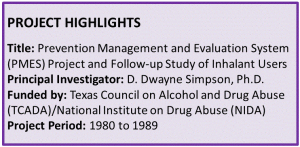Prevention Management and Evaluation System and Follow-up Study of Inhalant Users
Sniffing of toxicant inhalants — such as commercial solvents, toluene based glues, aerosols, paint, typing correction fluid — may result in severe physiological and psychological damage or death. This problem has been of particular concern among Mexican American and Native American youth, and questions have been raised about the longitudinal aspects of inhalant use and related consequences.

Follow-up research was therefore conducted on 110 Mexican American youth admitted to the Youth Advocacy Program in Austin, Texas, during 1981-1985. Most had a history of drug use and family, school, or legal problems, and reported different levels of inhalant use upon admission to the program. Follow-up interviews carried out approximately 4 years after program intake provided information about drug use and other related problems over time. All youth came from low socioeconomic neighborhoods, and many from single-parent homes. Two-thirds were male, with an average age of 19.5 years at the time of follow-up. Over three fourths had dropped out of high school, and only about half worked at a full-time job anytime during the year prior to the follow-up interview. Most still lived at home with parents or grandparents. Over half (mostly females) reported having one or more children, even though only 18% had ever been legally married.
Study results showed that while inhalant use by this high-risk sample of Mexican American youth generally diminished over time, continued use of other drugs was common. Marijuana and alcohol were used most often, but the prevalence of cocaine use increased threefold over the 4-year period, from 10% at the time of program intake to 31% in the year immediately preceding the follow-up interview. Use of stimulants, such as speed, also increased. Drug and alcohol use rates at follow-up were highest for those with the most extensive use of inhalant and other drugs before program intake; of this group, 45% reported they drank an average of over 4 ounces of 80-proof alcohol equivalent every day (the amount contained in 5 cans of beer). Most also continued to have serious legal and employment problems during the follow-up period.
This research project helped improve understanding of inhalant and other drug use and identified several objectives for behavioral intervention programs in this population. The findings suggest that prevention and early intervention efforts become increasingly difficult once youth become heavily enmeshed in drugs and related problems and that low cost and easy access to toxicant inhalants facilitate and encourage their use. Educational efforts and family support, on the other hand, seem to help change attitudes and reduce chronic or long-term drug usage. The findings reaffirm the importance of severing adolescent ties with deviant peers. Feelings of discrimination and alienation also need to be addressed as part of efforts to establish better social coping skills, reduce school dropout rates, and lower the frequency of teenage pregnancies by unwed parents. Care for physical health must be emphasized, along with education about the growing threat of AIDS.
Publications
Simpson, D. D. (1992). A longitudinal study of inhalant use: Implications for Treatment and Prevention. In C. W. Sharp, F. Beauvais, & R. Spence, (Eds.), Inhalant abuse: A volatile research agenda (NIDA Research Monograph 129). Washington, DC: U.S. Government Printing Office.
Simpson, D. D., & McBride, A. A. (1992). Family, friends, and self (FFS) assessment scales for Mexican American youth. Hispanic Journal of Behavioral Sciences, 14(3), 327-340. [Abstract]
Simpson, D. D., & Chatham, L. R. (Guest Eds.). (1991). Inhalant use by Mexican American youth: Findings from a longitudinal study. Special issue: Hispanic Journal of Behavioral Sciences, 13(3).